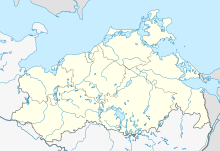Göldenitzer Moor nature reserve
Coordinates: 53 ° 59 ′ 52.4 " N , 12 ° 19 ′ 38.7" E
The Göldenitzer Moor nature reserve is a nature reserve in Mecklenburg-Western Pomerania between the surrounding villages of Gubkow , Teschow and Cammin . The protective purpose consists in rewetting an extensively peeled raised bog as a habitat for the rare animal and plant species that are bound to this habitat.
The legal determination took place in several phases: On July 10, 1939, the area was designated as a nature reserve, reduced in size in 1940 and 1961 and expanded in 1991, 1994 and most recently in 2008. It covers an area of 900 hectares. The state of the area is classified as unsatisfactory, since the majority of the originally existing raised bog has disappeared due to peat extraction. Re-wetting measures since 1992 show the beginning of repopulation of the original habitat as the first steps towards renaturation. The protected area cannot be entered on public roads.
History and water balance
Today's protected area areas were created during the last Ice Age as an excavation that is embedded in a ground moraine. After the ice thawed, several water-filled basins remained, which later muddy from the edge. On the initially formed silting Moor one started about 8000 years bog to develop. The Göldenitzer Moor is one of the oldest rain bogs in the state today. The black lake in the north and the Teschower lake in the south surround the high moor area. The moor is drained via two water courses: to the east through the Stegendieksbach and to the south through the ditches of the Teschower Wiesen.
Human use began quite late in the area. High moors were considered to be impassable, mysterious unland . The Wiebekingsche card built in 1786 and leads the surfaces as gehölz free and not dehydrated. At the beginning of the 19th century peat mining began in the western part , which was extended to the entire moor in the following decades. The Teschower See was drained through drainage ditches. The peat extraction was intensified considerably after the end of the Second World War. It was done mechanically initially with the aim of alleviating the fuel shortage. Parts of the nature reserve were rewetted in 1992. Peat mining may continue to be carried out on parts of the area up to 2015 through provisions in the unification agreement . 35,000 cubic meters of peat are removed annually.
Flora and fauna
The original raised bog vegetation can only be found on the southern slopes and in the peripheral areas of the peat cuttings. Typical peat moss there are the deceptive peat moss ( Sphagnum fallax ), the spit peat moss (Sphagnum cuspidatum) and the narrow-leaved peat moss (Sphagnum angustifolium) . Dwarf shrub heaths with swamp porch and common crowberry covered the area around the peat cuttings.
The bog provides habitat for numerous Herpeten as adder , grass snake , forest lizard , frog , common frog , moor frog and toad . Among the dragonflies, moss damsel species and the black darter are particularly noteworthy.
literature
- Göldenitzer Moor 30 . In: Ministry of Environment Mecklenburg-Western Pomerania (Hrsg.): The nature reserves in Mecklenburg-Western Pomerania . Demmler-Verlag, Schwerin 2003, ISBN 3-910150-52-7 , p. 288 f .
Web links
- NSG regulation with card
- Map portal environment of the State Office for the Environment, Nature Conservation and Geology Mecklenburg-Western Pomerania ( information ) with geodata
- Report on the excursion into the moorland
- Illustrated insights into peat extraction by the local company in Gubkow
- Newspaper report on peat extraction and renaturation (from November 23, 2005)




